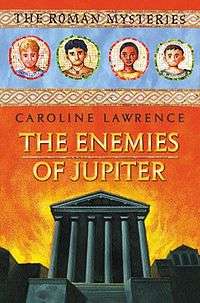The Enemies of Jupiter
|
First edition, 2003 | |
| Author | Caroline Lawrence |
|---|---|
| Cover artist |
Peter Sutton Fred van Deelan (mosaic) |
| Country | United Kingdom |
| Language | English |
| Series | The Roman Mysteries |
| Genre | Historical novel |
| Publisher | Orion Books |
Publication date | 6 November 2003 |
| Media type | Print (Hardback & Paperback) |
| Pages | 224 pp (first edition, hardback) |
| ISBN | 1-84255-251-1 |
| OCLC | 59305867 |
| Preceded by | The Twelve Tasks of Flavia Gemina |
| Followed by | The Gladiators from Capua |
The Enemies of Jupiter is a children's historical novel by Caroline Lawrence published on 6 November 2003 by Orion Books. It is the seventh book of the Roman Mysteries series.
Plot introduction
The novel is set in Ostia and Rome in February AD 80, at a time when Rome was devastated by disease and fire. Jonathan is the primary character in this novel, in which he tries to reconcile his parents, Mordecai and Susannah, and falls foul of the Emperor Titus.
Plot summary
Jonathan is still depressed about his mother's decision to remain in Rome with the Emperor Titus, but has decided it is time to act. Soon an imperial messenger arrives to summon Mordecai, in his capacity as a doctor, to the capital, where the fever which swept through Ostia in December has reached epidemic proportions. Apparently Titus also has a mystery for the four detectives to solve, as Jonathan, Lupus, Flavia and Nubia are included in the imperial request.
As they arrive at Rome they witness some horrible sights: crucified slaves, burning bodies, bloated corpses and Lupercalian wolf-boys capering in the streets sprinkling people with blood.
At the Imperial Palace the Emperor asks the children to look into a prophecy foretelling devastation when "Prometheus opens a Pandora's box". He assigns the astrologer Ascletario to act as a guide for the children (and the reader) to the sights and customs of Rome.
Flavia, Nubia and Lupus all develop theories about the prophecy - one rather spectacularly connected with the Ark of the Covenant which they find in the quarters of Berenice, the exiled mistress of the Emperor. Jonathan, however, is only interested in engineering a meeting between his parents - but when he does so, Titus intervenes and declares his love for Susannah. This upsets everyone, but especially Berenice who returns from exile just in time to hear it.
Distressed by the failure of his plans and the wrath of the Emperor, Jonathan runs blindly out into the city. Some boys beat and rob him, and he is rescued by Agathus who turns out to be Berenice's agent at the Golden House. He persuades Jonathan that his problems can be solved by killing Titus, and Jonathan reluctantly agrees, only to find out later that Agathus's real plan is to start a fire and destroy Rome. At the Temple of Jupiter on the Capitoline Hill Jonathan accidentally starts the fire while trying to stop Agathus. It causes widespread destruction, burning many temples and other buildings, and many lives are lost.
Jonathan survives, but feels guilty, believing that he is the Prometheus who opened the Pandora's Box as predicted in the prophecy. When he hears that his mother is also dead he gives up hope and signs on as a gladiator, expecting a quick death in the amphitheatre.
However, the report of Susannah's death was a ruse to fool Berenice, and she arranges to go to Ostia with Mordecai. They all believe Jonathan to be dead in the fire, especially when his stolen rings are found on an unrecognizable body.
Themes
A central theme is hubris, or excessive pride which challenges the gods and calls down retribution. Aristo defines the term in an early chapter and describes Jonathan's dismissive attitude to the gods as a fine illustration. Prometheus is the classical example given. Jonathan, Titus, the arrogant Roman doctors, and Agathus are all guilty in different ways.
Medicine as practised in the Roman empire, notably herbalism, humorism and bloodletting, is another theme. Mordecai's methods, which echo modern medical beliefs, are shown as the most effective.
Allusions to history
The fever and the fire are historical events. Titus, Berenice and Josephus are historical characters, although Berenice's visit to Rome and her possession of the Ark are only speculative.
